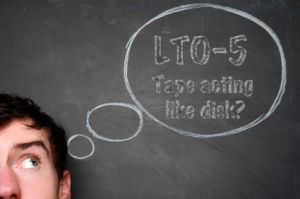LTO-5: Changing the Way You Look at Tape
In case you needed more proof of tape’s ongoing role in the data storage world, you’ll find it in a sales figure from late last year. Specifically, shipments of LTO-5 (Linear Tape-Open Generation 5) cartridges doubled from Q3 to Q4 2010, and this tape format now accounts for 10 percent of total cartridge sales. The LTO format in general, initially released in 2000, now comprises nearly 90 percent of the overall tape market.
Why are these figures and LTO-5 itself important to the conversation about tape’s continuing role in an enterprise storage strategy? Because LTO-5 is changing what have been accepted facts about tape in our industry for some time. As a result, here are some of the new facts of life when it comes to tape.

FACT: Tape is evolving.
The simple fact that leaders in our industry continue to develop newer, better and faster generations of tape tells us that this media is anything but stagnant. LTO-5 has twice the capacity and is 15% faster than its predecessor. Organizations will continue looking for these advances in cost-effective capacity, which will become even more relevant as data stores continue to grow exponentially and archive timelines lengthen. Although adoption of newer generations of LTO may take some time, especially in a recovering economy, offering increasingly better products to meet customer demand is one hallmark of an adaptive and evolving technology whose lifeline is far from at its end.
FACT: Tape can operate independently of the backup software.
There was a time when you could access data on a tape only using a machine that had the proprietary backup software loaded. With LTO-5 and the IBM-created, no-cost Linear Tape File System (LTFS), this challenge falls by the wayside and tape becomes easier and faster to use. Now, any computer running LTFS software can read any LTO-5 tape. This feature takes full advantage of the next new fact about tape…
FACT: Tape allows for easy file system access.
LTO-5 has added the capability to access files on tape just like you would on disk. This is because LTO-5 includes two data partitions that support a tape file system. One partition holds metadata that creates an index of the data on the tape, while the other partition holds the actual data. With LTFS loaded, the LTO-5 tape appears like a drive within the operating system, allowing for easy click, drag-and-drop file opening, deletion or modification. Again, faster, easier use positions tape for continued existence in the storage sphere.
FACT: Tape remains in demand.
The market is still alive for the economical and environmentally sound storage capacity that tape offers—especially as organizations look to archive data for longer due to compliance and legal requirements and to store an overabundance of rich media files. In fact, a while back, survey data showed that 60% of managers operating disk-only systems said they intended to add tape back into their environments.
With LTO-5 and LTFS, the tape industry is demonstrating its ability to keep up with—or maybe even ahead of—market demand. In my opinion, that’s proof positive that tape lives on.

